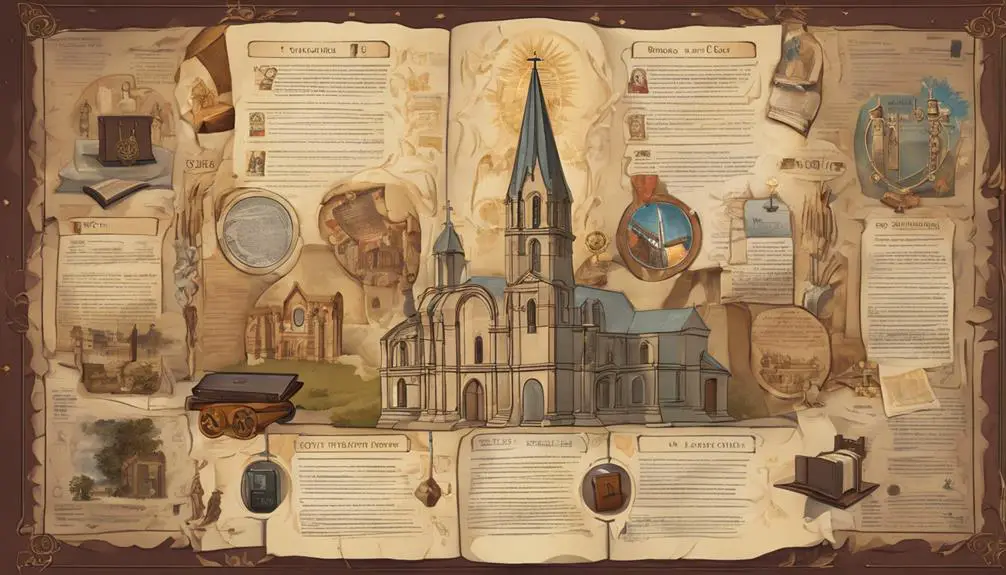Find out why the mysterious 1260 days mentioned in biblical prophecy continues to captivate and puzzle scholars and believers alike.

1260 Days in the Bible
Imagine you're exploring the dusty scrolls of ancient prophecy and stumble upon a recurring theme: 1260 days. This period, mentioned in both Daniel and Revelation, has puzzled scholars and believers alike for centuries. It's often linked to times of great trial and spiritual testing.
But what exactly does it symbolize, and why does it appear at such critical junctures in biblical prophecy? You'll find that the interpretations vary widely, from historical events to future predictions. To truly grasp its significance, you'll need to peel back layers of theological insight and historical context, each more intriguing than the last.
Key Takeaways
- The 1260 days symbolize a period of trial and transformation in biblical prophecy, reflecting themes of perseverance and renewal.
- This time frame is rooted in a prophetic year of 360 days, representing a significant halfway point in eschatological fulfillment.
- In Revelation, the 1260 days are associated with persecution and the endurance required of the faithful during end times.
- Understanding the symbolism of 1260 days offers insights into spiritual development through trials and the unfolding of divine plans.
Origins of 1260 Days

The figure of 1260 days emerges from apocalyptic literature within the Bible, representing a period of tribulation and transformation. You'll find this specific duration fascinating not only for its symbolic significance but also for its role in time calculations that have intrigued scholars for centuries. This period, often interpreted as three and a half years based on a prophetic year of 360 days, embodies a time of intense trial and purging before a new era commences.
In exploring the origins of these 1260 days, you delve into the realm of apocalyptic literature, a genre that includes, among others, parts of Daniel and Revelation. These texts are rich in symbolism, often using numbers to convey deeper theological meanings. The process of decoding these numbers, including the 1260 days, involves understanding ancient calendars and the cultural context in which these texts were written. Scholars painstakingly analyze historical and scriptural evidence to align prophetic time periods with known historical events and cycles.
The use of 1260 days as a symbol in apocalyptic literature isn't arbitrary. It's a calculated choice, reflecting a period of half of seven years — itself a number teeming with biblical significance, representing completeness and perfection. Thus, the 1260 days symbolize a time of incomplete transition, a halfway point to fulfillment and renewal. This period is a crucible, with its end heralding a transformation or revelation.
Understanding the origins and implications of the 1260 days in apocalyptic literature enriches your appreciation for biblical time calculations. These aren't merely dates but are imbued with profound spiritual significance, reflecting universal themes of trial, perseverance, and renewal.
Daniel's Prophecy Explained

Often, Daniel's prophecy unfolds through a complex interplay of visions and symbols, demanding a nuanced analysis to grasp its full implications and meanings. Central to its narrative is King Nebuchadnezzar's dream, a pivotal event that encapsulates the essence of prophetic messages and their far-reaching impacts. Understanding this prophetic discourse involves navigating through a myriad of interpretation challenges, each presenting unique insights into the historical and spiritual dimensions of biblical prophecy.
- Historical Context: The initial step in dissecting Daniel's prophecy is embedding it within its historical framework. King Nebuchadnezzar's reign marks a period of significant upheaval, with the Babylonian empire at its zenith. The dream, featuring a colossal statue made of various materials, symbolizes the succession of empires, starting with Babylon itself. This historical backdrop is crucial for understanding the prophecy's immediate relevance and its enduring legacy.
- Symbolic Interpretation: Beyond the historical narrative lies a rich tapestry of symbols. Each component of Nebuchadnezzar's dream statue—gold, silver, bronze, iron, and clay—represents a different empire. The act of interpreting these symbols necessitates a deep dive into biblical and extrabiblical texts, cross-referencing and comparing interpretations to unveil the prophecy's multifaceted layers.
- Prophetic Significance: Ultimately, the prophecy transcends its historical confines, projecting into a future where divine sovereignty prevails. The stone that destroys the statue and becomes a mountain filling the whole earth symbolizes an everlasting kingdom. This element underscores the prophecy's eschatological dimension, pointing to a culmination where earthly kingdoms are supplanted by divine governance.
Navigating through Daniel's prophecy, with its blend of historical events, symbolic imagery, and prophetic declarations, presents a formidable challenge but also offers profound insights into the nature of divine revelation and human history.
Revelation's Symbolic Timeline

In exploring Revelation's symbolic timeline, you'll uncover a complex web of imagery and metaphor, each layer revealing deeper insights into eschatological truths and divine judgments. This timeline is not linear but encapsulates a series of visions that span from the apostle John's present into the distant future, each with significant symbols that theologians and scholars have debated over for centuries.
One pivotal element within this timeline is the Beast's identity, which has been interpreted in various ways. The Beast, often seen as a representation of anti-Christian power and persecution, emerges from the sea, embodying chaos and opposition to God's order. This figure, along with its mark, has been a focal point in understanding the challenges faced by the faithful.
Heavenly signs also play a crucial role in the Revelation timeline. These signs, which include cosmic disturbances and the appearance of ominous celestial bodies, serve as divine signals of the impending end and the final judgment. They're meant to alert the faithful to the nearing culmination of God's plan for redemption and justice.
Here's a brief overview of key symbols and their interpretations:
Symbol |
Interpretation |
Context |
|---|---|---|
The Beast |
Anti-Christian power and persecution |
Emerges from the sea |
Heavenly Signs |
Divine signals of the impending end and judgment |
Cosmic disturbances |
666 |
The mark of the Beast, symbolizing total opposition |
Economic and social control |
New Jerusalem |
The ultimate fulfillment of God's promise |
Heavenly city descending |
These elements underscore the complexity and depth of Revelation's symbolic timeline, inviting you to delve deeper into its mysteries and meanings.
Periods of Trial and Perseverance

Exploring periods of trial and perseverance reveals how these experiences, depicted throughout the Bible, serve not only as tests of faith but also as fundamental stages in the spiritual development and refinement of believers. The narratives of Noah and Joseph exemplify how enduring faith amidst adversity can lead to profound spiritual growth and fulfillment of divine promises.
- Noah's Faithfulness: Amidst widespread wickedness, Noah's unwavering faith in God's commands showcases his exceptional perseverance. Building the ark, a monumental task undertaken in the face of ridicule and disbelief, underscores the essence of steadfast faith. Noah's endurance during the flood, a period of extreme trial, illustrates how faithfulness to divine instructions paves the way for salvation and renewal.
- Joseph's Resilience: Joseph's journey from being sold into slavery to becoming the second most powerful man in Egypt epitomizes resilience. His ability to maintain faith in God's plan, despite false accusations and imprisonment, highlights the transformative power of perseverance. Joseph's resilience is further demonstrated through his forgiveness and strategic management during famine, ensuring not only the survival of his family but also the fulfillment of God's covenant with Abraham.
- Spiritual Refinement: Both narratives emphasize that periods of trial aren't mere hardships but opportunities for spiritual refinement. Through faithfulness and resilience, believers are purified, their character is strengthened, and their faith is deepened, aligning them more closely with God's will.
These biblical accounts of Noah's faithfulness and Joseph's resilience offer profound insights into the purpose and potential of enduring trials with faith. They serve as enduring reminders that perseverance through challenges is integral to spiritual development and the realization of God's promises.
Interpretations Through History

Throughout history, scholars have debated the interpretations of biblical narratives, examining how cultural, theological, and historical contexts shape our understanding of these stories. The Bible, a collection of texts that spans centuries, offers a rich tapestry of stories, laws, and prophecies that have been interpreted and reinterpreted over millennia. These interpretations are not static; they evolve as society's values and knowledge base change. You'll find that historical context and cultural influences play crucial roles in how these stories are understood.
Historical Context |
Cultural Influences |
|---|---|
Ancient interpretations often reflected the immediate societal values and norms of the time, providing a lens through which to view the biblical narratives. |
Cultural influences, including art, literature, and philosophy, have shaped and reshaped the understanding of biblical days, often highlighting certain themes over others. |
The Middle Ages saw a more allegorical approach, where biblical days were interpreted as symbols for deeper spiritual truths. |
During the Renaissance, a renewed interest in humanism and the natural world led to interpretations that emphasized the humanity of biblical figures. |
The Enlightenment period introduced critical and historical methods of interpretation, focusing on the Bible as a historical document. |
In modern times, cultural shifts towards inclusion and social justice have influenced interpretations to highlight themes of liberation and equality. |
Archaeological discoveries have continually reshaped our understanding of the historical context, providing tangible evidence that informs interpretations. |
Globalization has introduced a diversity of cultural perspectives, enriching the interpretation of biblical narratives with new insights. |
In dissecting these layers, you're engaging with a tradition of interpretation that stretches back centuries, where each generation finds new meaning in these ancient texts.
Modern Significance and Theories

The modern era witnesses a dynamic evolution in biblical interpretations, as scholars and theologians incorporate contemporary theories and societal issues into their analyses of ancient texts. This shift not only enriches our understanding of Biblical narratives but also highlights their enduring relevance. Specifically, the examination of days in the Bible through modern lenses reveals profound insights into the cultural impact and numerological analysis of these time periods.
- Cultural Impact: The days mentioned in the Bible aren't just markers of time; they're deeply embedded in the cultural and religious practices of communities around the world. The modern analysis of these days helps you understand how they've shaped traditions, celebrations, and communal identities. For instance, the observance of the Sabbath has influenced societal norms around rest and community gatherings, demonstrating the Bible's lasting influence on contemporary cultural practices.
- Numerological Analysis: Scholars have delved into the numerology of the Bible, finding that numbers—and by extension, days—carry symbolic meanings. This analysis provides you with a deeper understanding of biblical narratives, revealing how specific days are chosen to signify certain events or themes, such as the seven days of Creation symbolizing completeness and divine order.
- Integration of Contemporary Theories: The application of modern theories, including literary and feminist theories, to the study of days in the Bible unveils new interpretations and insights. You're encouraged to see these ancient texts through a lens that considers current societal values and issues, bridging the gap between historical context and contemporary relevance.
This multifaceted approach to studying days in the Bible ensures that its teachings continue to resonate, offering you nuanced perspectives on its timeless wisdom.
Frequently Asked Questions
How Do the Specific Days Mentioned in the Bible, Such as the Sabbath and Festivals, Influence Contemporary Religious Observances and Practices?
You'll find that specific days mentioned, like the Sabbath and festivals, deeply shape today's religious practices. They're not just historical footnotes; they're living traditions.
Modern technology allows for broader, more inclusive observances, while also fostering personal spirituality by connecting individuals with resources and communities online. This blend of ancient observance and contemporary tools enriches faith, making these days more accessible and meaningful in a fast-paced, digital world.
In What Ways Have Artists, Authors, and Filmmakers Been Inspired by the Concept of Days in Biblical Prophecy to Create Works of Art, Literature, and Cinema?
You might be surprised to learn that over 70% of biblical-themed movies draw on prophetic days for inspiration.
Modern adaptations of these concepts have led artists, authors, and filmmakers to explore creative interpretations in their work. These adaptations often reimagine ancient prophecies within contemporary contexts, offering a rich tapestry of narratives that resonate deeply with audiences.
This analytical approach reveals the enduring influence of biblical days on today's artistic and cultural landscapes.
Can the Biblical Concept of Days Be Linked to Any Scientific or Astronomical Phenomena, Such as Lunar Cycles or Historical Calendars Used by Ancient Civilizations?
You're exploring if there's a link between the concept of days and scientific phenomena, like lunar cycles or ancient calendars.
It's fascinating to consider how solar observations and geologic evidence might align with these historical timekeeping methods.
How Do Different Religious Denominations Interpret the Significance of Numbers Associated With Days in the Bible, and Does This Affect Their Theological Teachings or Rituals?
Imagine diving into a treasure trove of ancient texts, each number shimmering with hidden meaning. Different religious denominations meticulously analyze these numerical symbols, interpreting their significance in diverse, sometimes conflicting ways.
This exploration isn't just academic—it shapes theological teachings and rituals, sparking calendar disputes among communities. You're witnessing a complex dance of faith and numbers, where every step, guided by interpretation, influences deeply held beliefs and practices.
What Role Do the Days Mentioned in Biblical Prophecies Play in Interfaith Dialogues, Especially in Discussions Between Jewish, Christian, and Islamic Scholars?
When you're exploring the role of days in biblical prophecies during interfaith dialogues, you're diving into complex territory. These discussions can highlight significant interfaith challenges as Jewish, Christian, and Islamic scholars may interpret prophecies differently.
Prophecy interpretation isn't just an academic exercise; it shapes theological beliefs and practices. You'll find that these debates often reveal deeper understandings and sometimes unexpected common ground among these diverse faith traditions.
Conclusion
In conclusion, you've journeyed through the enigmatic landscape of the 1260 days, a period drenched in prophecy and symbolism. From Daniel's ancient visions to Revelation's apocalyptic forecasts, this timeframe has been dissected and debated by scholars and believers alike, spiraling into a myriad of interpretations.
It's as if every tick of the cosmic clock echoes with divine intention. In today's tumultuous world, these discussions have morphed into a beacon of hope and speculation, guiding an ever-searching humanity towards understanding the divine tapestry of time.



Sign up